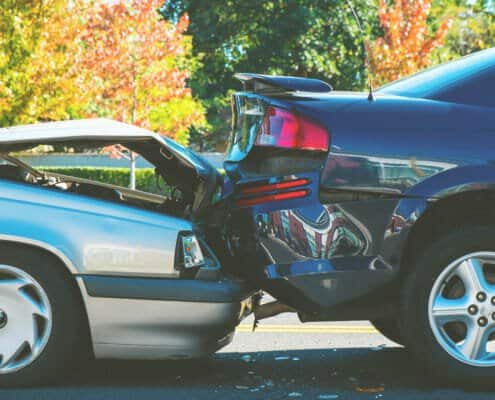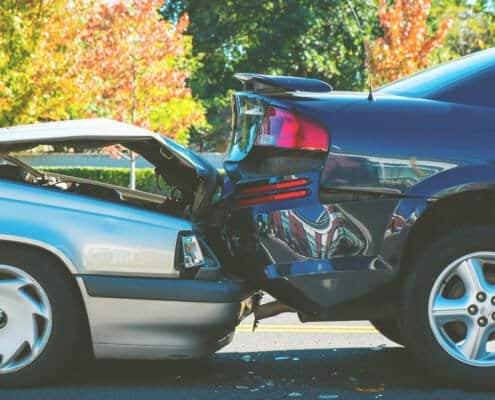
Car accident, car crash, car wreck; no matter how it’s phrased, it always ends in injury. From bruises and scratches to fatality, it is a daily occurrence. In the United States alone, 16,438 car accidents are resulting in 90 deaths per day. In these accidents, the cars are not the only ones to receive damage, but people are too. Depending on the type of accident, the injuries an individual sustains range from mild to severe. Whether that damage is physical, internal, or both, many everyday injuries occur from car accidents.
Bruises and Scratches
Many people involved in car accidents would be lucky to walk away with minor bumps and scratches. Two cars’ collision usually involves being rattled around behind the life-saving seat belt, a slam into the vehicle’s side panel, and hitting the steering wheel. While they do not require immediate medical attention, they can result in stitches and temporary bruising—the mildest form of injury with the fastest healing process. Broken glass, torn sheet metal, or flying objects can cause lacerations. Bruises are caused by the impact of the body against any item, or vice versa. Road rash is abrasion caused by friction from being dragged or skidding on pavement or concrete.
Whiplash
While rattling in a car during the accident, your body contorts into positions that are quick and painful. One of the functions can be the shaking motion straining muscles and ligaments in the neck, causing whiplash—the stretching of soft tissue results in pain and discomfort. The following weeks after an accident can create stiffness in the neck and impact the amount of mobility. The healing process can take a few weeks for the muscles to recover. Still, depending on how severe the accident’s movement can be, some damage done to the muscles and ligaments can be permanent if not treated with physical therapy. Whiplash can occur in collisions moving as slow as 15 mph, making it a common injury. More severe whiplash impacts can result in tinnitus, memory problems, odd sleeping patterns, and even depression.
Burns
Depending on the severity of the accident, the impact of damage inflicted on the car can release steam or chemicals. Vehicles in accidents can leave victims exposed to heat, electrical breaks, and toxic chemicals. When in contact with the skin, the damage penetrates layers of tissue within the skin. Burns range from first degree to third-degree contingent on exposure to the skin and level of damage inflicted. Some burns only form on top of the skin, while some run deep into the tissue leaving damage to the nerves and skin tissue. After complete development, doctors can assess the level of damage done to the skin.
Airbags, exposures to chemicals, fires and explosions, electrocution from wiring, and hot metal or steam contribute to burns. If the burn runs deep enough, there is numbness surrounding that part of the body where the extensive damage cannot be felt. If clothing or items are stuck to the skin from the burn, it is best to leave it until a medical professional can remove the items.
A typical response to burns is a shock as the body processes the physical damage.
Its defense tries to protect itself from any further trauma, so many burn victims do not feel the pain until the accident’s shock wears away. Symptoms of burns include shallow breathing, nausea and vomiting, loss of consciousness, and feeling dizzy or lightheaded. It is vital to stay hydrated to help the body heal internally from the burns and begin the healing process. Burns have a variety of stages during the healing process depending on the degree of the burn. First degree are easily treatable and do not leave lasting damage besides possible discoloration or scarring. Second and third-degree level burns can interfere with an individual’s daily life and need surgery to replace damaged skin through skin grafts. Physical differences can leave many victims disfigured bodies permanent damage.
While burns are a bodily injury, they can contribute to psychological damage as well. In worst cases of burns that require skin grafts leaving victims to become disfigured and drastically change appearance, the sudden change can alter an individual’s emotional wellbeing. Emotional trauma from third-degree burns can leave victims with self-esteem issues, stress, and anxiety. Speaking with a psychologist on coping with the sudden change in daily life is the best treatment to help overcome emotional distress from injuries.
Concussions
During a crash, when whiplash occurs, it can throw your head around in all sorts of directions and hitting it against all sides of the car. If struck hard enough, a concussion can occur and lead to brain injury. The impact of collision leaves many individuals with memory problems, headaches, blurry vision, light sensitivity, and vomiting. Some reports have said people suffering from concussions feel like their brain is not working as fast as it usually does.
Concussions result from bruising on the brain from the impact on the skull. Milder forms of concussions can heal on their own as the bruising heals. Still, more severe conditions of concussions require medical attention and monitoring to ensure no lasting effects of damage on the brain. Traumatic brain injury stems from severe traumas, and 50,000 people die each year from TBI. The brain can suffer long-term disabilities changing the way it functions, processes emotions, and processes information. Many individuals who experience TBI develop lifelong memory issues and motor problems.
Broken Bones
Out of the physical injuries acquired during an accident, one of the worst side effects can be broken bones. The stress your body withstands while being contorted into positions it isn’t meant to be can cause fractures and breaks. Most broken bones are either arms or legs and are rarely fatal, but if the bone breaks abnormally, then surgery may be required. The bones need to be set with a cast, and you’ll undergo a month or two of healing. Certain breaks are much more painful and have an extensive healing process: ribs, pelvis, collar bone, the skull, and the spine. The collar bone and shoulder absorb much of the body’s shock when force is applied, such as slamming into the car’s steering wheel or dashboard.
Bones tend to lock in position during trauma, causing injury to all parts of the body where the trauma occurs. While not as expected, the recovery period is stressful both physically and emotionally due to nearly all cases requiring surgery to repair the damage. Rare circumstances include severance of fingers, toes, and some limbs. Corrective surgery can solve the issue, but extreme accidents cause amputation. A combination of surgically setting the bones and physical therapy will boost your recovery period and strengthen your body after a crash.
Internal Bleeding
While it is easy to see physical damage done to your body, internal damage can be near-fatal if not appropriately treated. Organs are much more intricate and complex to repair than bones. When organs endure blunt force trauma, they bleed, causing internal bleeding leaking into other parts of your body. In high-speed accidents, internal bleeding is a common benefactor. What makes it fatal is some internal bleeding cannot be felt, causing most car accident victims not to seek treatment, further damaging their organs. Individuals suffering from inner bleeding experience bruising, painful abdomen and chest, shortness of breath, nausea or vomiting, and blood pressure drops, causing them to feel weak, dizzy, and sometimes fainting.
The most severe type of internal bleeding is in the skull surrounding the brain. Physical symptoms of internal bleeding in the head include numbness, tingling in hands or feet, migraines, blurred vision, hard hearing, imbalance, slurred speech, blackouts, and confusion. the most dangerous form of internal bleeding and the leading cause of fatalities from collisions worldwide. Surgery is required in most cases to repair the internal damage and expel blood from the body. Medication and physical therapy are the best methods of treatment after surgery.

Post Traumatic Stress Disorder
Much like how internal bleeding cannot be seen physically, PTSD is considered a psychological injury. Mental and emotional wounds are more difficult to treat since there is no casting, surgery, or bandaging up psychological trauma. It has the most prolonged healing period and varies from person to person. It impacts an individual’s ability to drive a car again or even sit in a car if they were a passenger during an accident. Psychological distress affects daily life and routine and will cause lasting damage to brain health if left untreated by a psychologist. PTSD can include feelings of guilt for inflicting pain on the other party or having more minor injuries than the other impacted individuals involved in the accident.
Typical symptoms include stress and anxiety, flashbacks of the accident, depression, difficulty sleeping, and avoidance of people or places related to the trauma. There are treatments available for treating PTSD by consulting a psychologist. Psychotherapy and medication are recommended for optimal results in processing trauma. However, what may work for one individual may not work for another, so it is crucial to work with a doctor to find what works best. Seeking treatment for psychological injuries is just as dire as seeking help for physical injuries.
To prevent injury from a car accident, take precautions when driving. Remember always to wear a seatbelt, adhere to the road’s laws and policies, and look out for other cars to avoid a collision. Safety should be a priority when driving, and it is crucial to look out not only for yourself but also for others to lower the risk of an accident.




